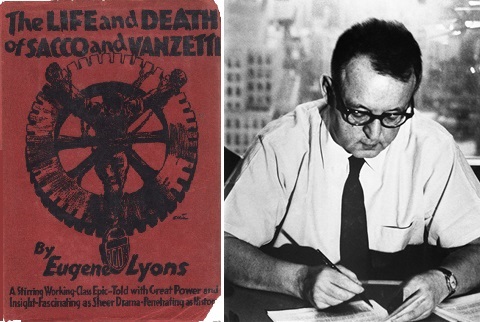|
| |
Eugene Lyons, Life and Death of Sacco and Vanzetti (1927)
The journalist Eugene Lyons was born in Russia, and emigrated to American in 1907. In his youth he was a Communist, worked with the unionist Workers' Defece Union, and wrote for Communist publications, before going to Soviet Russia as the United Press Correspondent in Moscow (1928-34). There, he became highly critical of the Soviet Union. In 1920, on a trip to Italy, he met Nicola Sacco's brother, who was the Mayor of Torremaggiore. Returning to America, he joined the campaign to free Sacco and Vanzetti, and wrote the book Life and Death of Sacco and Vanzetti (1927) supporting their innocence. In 1937, in his book Assignment in Utopia describing his time in the Soviet Union, Lyons summarised his involvement with the Sacco and Vanzetti case (which passage you can read with profit here, pages 29-36). Lyons made no attempt to be objective, and protrays the men as innocent heroes. The book is a full-blown statement of the case for their defence, and an indictment of the system Lyons believed had betrayed them.
***
Some Quotes:“A thousand different factors contributed toward that extraordinary growth of the case. The obscurity of the simple, uncouth protagonists; the unctuous smugness of the Brahmin New England which rallied against them; the fury of Red-baiting in America in the post-war years—everything combined to give the drama and the players a heightened significance. The protracted struggle achieved a peculiar symbolic quality for all men in their own lives. It challenged their institutions and tested their professed ideals. It ripped the varnished surface off American life and revealed the deep fissures of class and race antagonisms underneath. A simple murder case, it evolved into a complicated and terrifying sacrificial rite.” “These aliens by a strange chance combined in their obscure persons all the things that most offended and frightened a smug New Englander. In a section where family pride and an ingrown sense of racial superiority flourished, Sacco and Vanzetti were from the lowest social layer of wops and hunkies and polaks. At a time when Bolshevism gave householders nightmares, Sacco and Vanzetti were by their own confession reddest of the Reds. With the textile industry drifting to the South and the shoe industry to the West, in a period of strikes and discontent, Sacco and Vanzetti were self-confessed labor agitators. Amidst a raging blood-fed patriotism, they were slackers. In Puritan New England they were atheists. It required no special effort or apparatus to generate fear of and hatred for the two men. They attracted the fears and hatreds already in full play.” “The belief of some that agents of the Department of Justice and of the State of Massachusetts got together and decided to electrocute them, innocent or guilty, is naive. It was not a frame-up in the ordinary sense of the word. It was a far more terrible conspiracy: the almost automatic clicking of the machinery of government spelling out death for two men with the utmost serenity. No more laws were stretched or violated than in most other criminal cases. No more stool-pigeons were used. No more prosecution tricks were played. Only in this case every trick worked with a deadly precision. The rigid mechanism of legal procedure was at its most un-bending. The human beings who operated the mechanism were guided by dim, vague, deep-seated motives of fear and self-interest. It was a frame-up implicit in the social structure. It was a perfect example of the functioning of class justice, in which every judge, juror, police officer, editor, governor and college president played his appointed role easily and without undue violence to his conscience. A few even played it with an exalted sense of their own patriotism and nobility.” “Of the same race, the same political faith, their destinies inter-twined, they were yet men of the most contrasting temperaments and minds. Sacco was the Latin at his most impetuous, a man of emotion rather than logic, driven literally to madness on at least two occasions by the ordeal of imprisonment and waiting. The separation from his pretty red-headed wife and his two children, from friends and work, consumed his flesh and shook his reason. With every year of imprisonment Vanzetti seemed to grow calmer, gentler, more philosophic. His was the consolation of genuine martyrdom in which there was no rancor but an ever-deepening understanding.” “The scene while he was being strapped into the electric chair, when he proffered his forgiveness to those who were about to snuff out his life, belongs among the high moments in the history of the human spirit.” “They died like heroes. Even their enemies excalimed in awe-struck admiration. As to their friends – for them old frayed words like ‘martyrs’ and ‘heroes’ have become young and real. They have acquired names and a history.” “The rigmarole of legalistic gestures unrolled slowly and dully. More motions for a new trial based on new evidence, confessions of perjury by state witnesses, exposés of other state witnesses as criminals – and every motion matched by a denial from the self-righteous Judge Webster Thayer. All the forms of justice were preserved, only the spirit was absent. Many years later I wrote: ‘Sacco and Vanzetti were given all their legal rights. They were deprived only of their liberty and their lives.’”
|
The Life and Death of Sacco and Vanzetti is still regularly cited as a source in modern history books. Joughin & Morgan (1948) noted the worldwide sales of the book and recommended it as a biography which “brings to life the men and the society in which they lived”. William Maring (1995), however, stresses that the book is
biased towards its subjects, describing it as a cataloguee of “extraordinary appeals” to different groups,
representing Sacco and Vanzetti, now as the children of smiling peasants,
now as penniless poor, then
melodramatic heroes,
or “comfortably fixed” (for the white middle-class), or well-read idealists
(for the intellectuals).. |
|
| |
